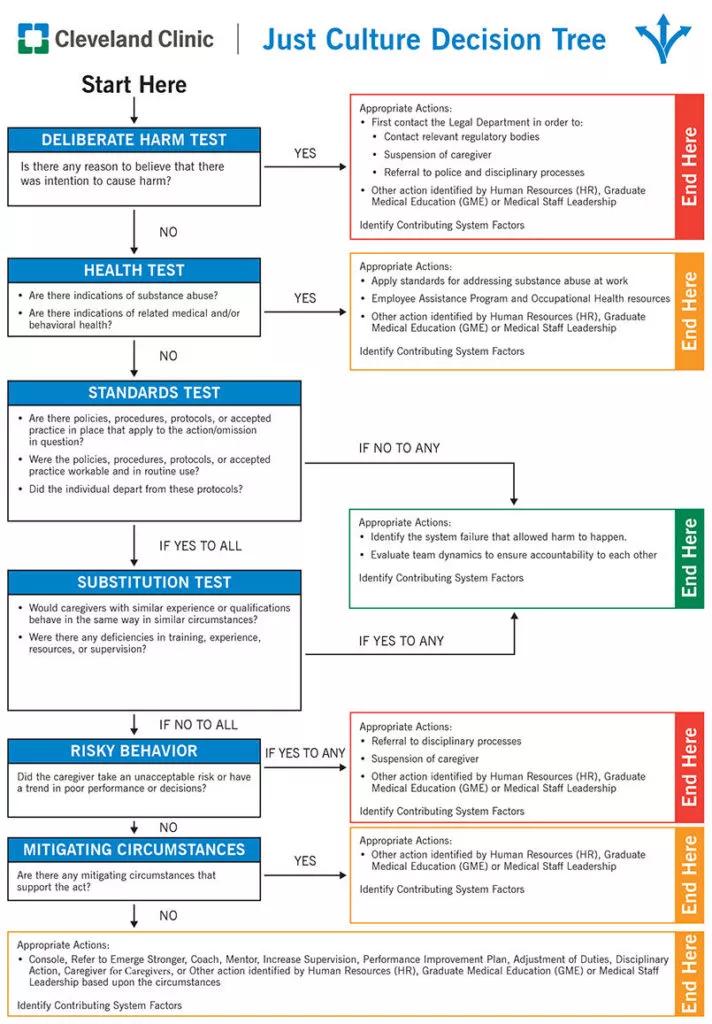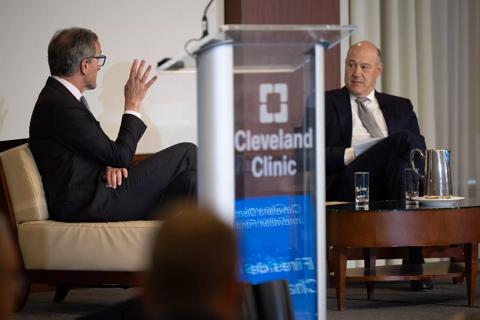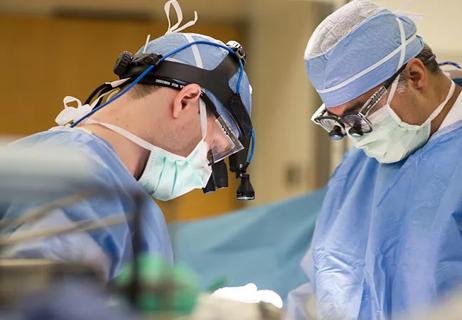Advertisement
How to empower caregivers and engage patients in patient safety

By Leslie Jurecko, MD, MBA
Advertisement
Cleveland Clinic is a non-profit academic medical center. Advertising on our site helps support our mission. We do not endorse non-Cleveland Clinic products or services. Policy
In an incredibly turbulent time in medicine, it’s essential that the health and healing of patients remain our primary focus. While all healthcare institutions want to avoid serious safety events (SSEs) and strive to continually improve patient safety and quality, many fall into traps that – at best – distract from their goals.
Over the years that I’ve been studying and leading safety and quality, I frequently return to the a handful of experts whose thought leadership in the areas of patient safety, quality, systems thinking and high reliability is foundational to making sustained improvements. The 10 mindsets below shape the way I lead every day at Cleveland Clinic.
Healthcare in the U.S. has a high rate of patient harm and workforce injury. By identifying the risks and anticipating issues, we can develop plans to protect caregivers so that they can protect patients. The late Paul O’Neill advocated for recognizing the physical and psychological safety of the healthcare workforce is a precondition for patient safety. Caregivers can be exposed to pathogens, violence and musculoskeletal insults on a routine basis. There is also the emotional toll and high rates of burnout in healthcare that can impact safe care. As leaders, we must commit to keeping our caregivers safe so they may keep our patients safe. Start by learning your organization’s Days Away, Restricted or Transferred (DART) rate and Total Case Incident Rate (TCIR).
Oversimplification gets us into trouble. There are no shortcuts in patient safety issues, which tend to be more complex than we think. Errors are often the result of multiple things going wrong, and a range of interventions may be required to improve safety. Karl Weick and Kathleen Sutcliffe taught us the five principles for high reliability organizations, including a reluctance to simplify interpretations. There are many ways in which systems can fail – complex systems fail in complex ways. Leaders must constantly seek facts that challenge their current beliefs as to why these failures occur rather than describing them in general turns and moving on. Similarly, action planning must be robust and sustainable. Avoid limiting action plans to education and policy changes that are simplistic and rely on humans to “get it right next time.” Strong action plans make it easy to do the right thing and hard to do the wrong thing by leveraging technology, reducing distractions, incorporating back-ups in high-risk processes, and incorporating engineering controls and workflows that reduce unnecessary steps.
Patients and their families offer unique and essential insights into their experiences. Cleveland Clinic recognizes that patients are important members of their care team. We have created councils of patients and family members to share their perspectives on the design and delivery of care across the institution. These diverse teams of volunteers, referred to as Healthcare Partners, work with Cleveland Clinic caregivers to transform healthcare, shape relationship-centered care, and support our vision of Patients First.
Mistakes can lead to positive changes. As leaders, the first step we should take when we hear about a mistake is to take a deep breath. When we react right away, we are likely to react from a purely emotional place that discourages our colleagues from raising issues in the future. As leaders, we need to recognize that this reactive response reaches the ears of the frontline team involved in the mistake. Even if our intention was to support, when we lead from a place of reactivity from the top our frontline hears, “The boss is involved and is mad.” A pause and deep breath allow us to see the error or mistake in context, and to identify opportunities for improvement before reacting or blaming caregivers. Amy Edmondson reminds us that “psychological safety is a belief that one will not be punished or humiliated for speaking up with ideas, questions, concerns or mistakes.” The pause helps us nurture a culture of psychological safety in which individuals are encouraged to discuss failures and mistakes. Then ask the growth mindset questions:
Advertisement
Punitive responses to errors shut down a culture of safety. Lucian Leape attests, “The single greatest impediment to error prevention in the medical industry is that we punish people for making mistakes.” As leaders, our job is to find and fix system issues. Rarely does the error fall on only the individual. At Cleveland Clinic, we have committed to training our leaders on an enterprise-wide Just Culture decision guide (below) created from a combination of the work of David Marx and James Reason. Reason writes that a Just Culture is an atmosphere of trust in which people are encouraged – and even rewarded – for providing essential safety-related information while maintaining professional accountability. At Cleveland Clinic, we use this decision guide to ensure that individual caregivers are not blamed for system failings while also ensuring accountability to standards of behavior and not tolerating conscious disregard of clear risks to patients and gross misconduct. There can be no punishment for honest mistakes.

Ronald A. Heifetz taught us that what gets our attention as leaders will be the focus of the teams around us. The key is focusing your attention on the right problems at the right time and continuously attending to foundational values like safety and quality. It may seem easier to avoid the difficult conversations around preventable harm or unreliable processes, but it is critically important for hospital leaders to talk openly about them. At Cleveland Clinic, our executive team — led by our CEO — discuss recent SSEs at length on a weekly basis. Additionally, new SSEs from across our health system are escalated from the bedside to the CEO as part of our daily tiered huddle process. We spend a significant portion of the agenda on safety. Safety is our #1 focus. The minute this falls off the agenda of top leaders is the minute the attention of the organization wanes.
As Brené Brown says, “Every time we are brave with our lives, we make the people around us a little braver, and our organizations bolder and stronger.” When we acknowledge our own imperfections, we remove some of the stigma associated with human error and create more resilient workplaces where errors are acknowledged as learning opportunities. Encourage your leaders to use a ‘failure bow’ as a symbol to the greater organization that failure is seen as an opportunity to learn and not as a career-ending mistake. I find myself as a leader doing failure bows almost every day, how about you?
When working to identify the root cause of a problem, many industries use ‘The 5 Whys’ technique. Asking “why” is not only for root cause analysis, but is crucial for humble inquiry. As Edgar H. Schein has taught us in his book, Humble Inquiry: The Gentle Art of Asking Instead of Telling, leaders need to keep digging deeper, asking questions of caregivers and patients to which we may not know the answers in order to solve the system problems instead of the symptoms.
While professional storytelling helps people connect with purpose and can be quite powerful, leaders must take care to avoid the trap of making decisions based on gut reactions to a story without data. Data reveal signals and opportunities to make meaningful improvement. In safety and quality, we are in the business of data. We use statistical process control (based on the work of Walter A. Shewhart) to help us detect areas of opportunity, to measure the outcomes of our interventions and to ensure that our improvements are sustained. High reliability leaders ask for data first before jumping to conclusions or decisions.
Advertisement
A change in one part of the system always causes a change in another part of the system. As Edwards Deming’s Theory of Profound Knowledge describes, organizations are a system of interrelated processes. Key to change management is the anticipation of downstream effects. Improving complex systems is evolution — not revolution. Go slow with change, engage stakeholders early and anticipate how other parts of the system will be impacted or possibly cause harm to patients.
Advertisement
Leslie Jurecko, MD, MBA, is Chief Safety and Quality Officer of Cleveland Clinic Health System, and a pediatric hospitalist with Cleveland Clinic Children’s. As Chief Safety and Quality Officer, Dr. Jurecko is responsible for the development and implementation of Cleveland Clinic’s Enterprise Quality and Safety strategy and driving high reliability across the enterprise.
The annual Patient Experience: Empathy and Innovation Summit is going digital!
This world-renowned summit is uniquely positioned to be the driver of empathy in healthcare. Just because we aren’t gathering in person doesn’t diminish the inspirational and collaborative discussions that will take place over the two-day digital summit.
Advertisement
Advertisement

Cleveland Clinic and IBM leaders share insights, concerns, optimism about impacts

Cleveland Clinic will offer rapid, pinpoint airborne transport of medications and other medical items

Dedicated committee and surgical fellowship strive for sustainability, energy efficiency, waste reduction

Next-generation mRNA vaccines are among the advancements likely to change healthcare this year

$50 million pledge will help remove sources of lead exposure from Cleveland homes

Summit to cap off with Annual Top 10 Medical Innovations

The spine surgeon will oversee more than 125 staff physicians in his new role

Merlino rejoins Cleveland Clinic to help execute bold strategic vision